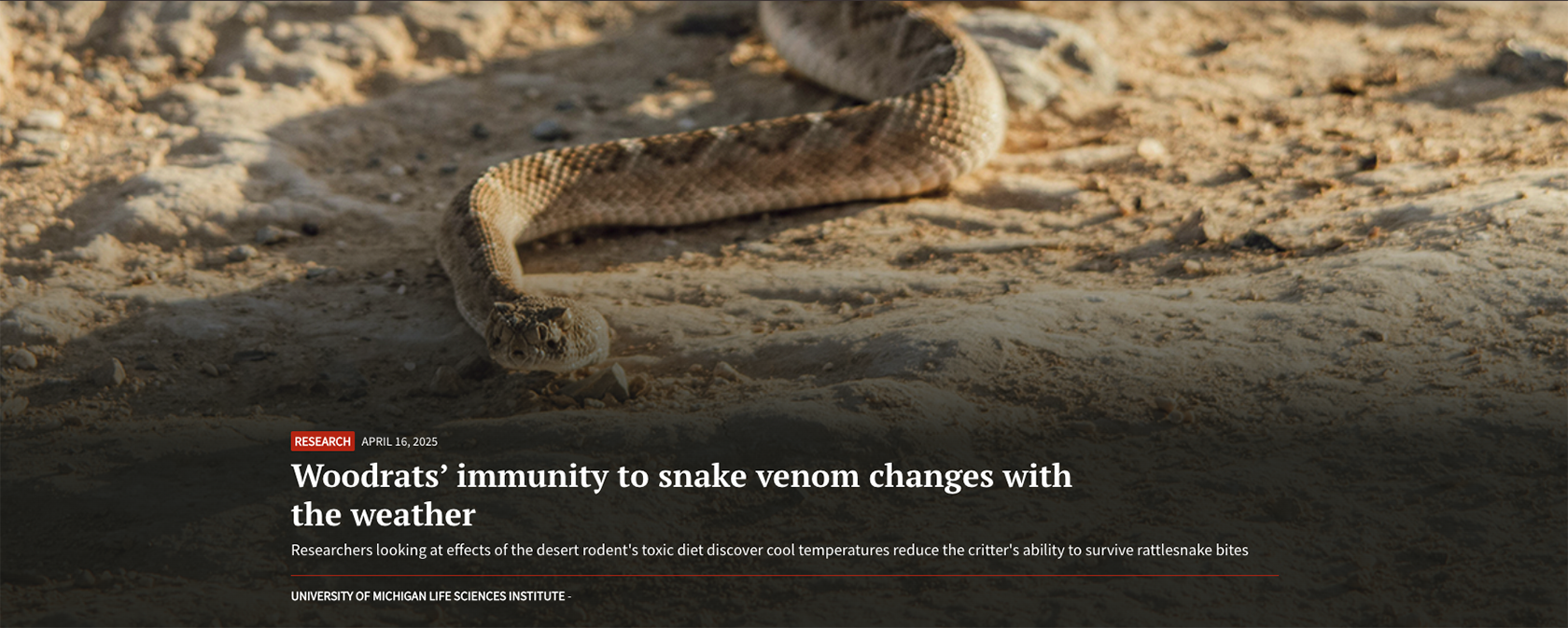
Adapted from a press release produced by the University of Michigan.
The power of a rattlesnake’s venom to incapacitate its prey may depend on more than just its potency, or even the prey animal’s tolerance for the poison. According to a new study published Tuesday in Biology Letters, it also depends a bit on the weather.
“Even across different populations of the same snake species, eating the same prey, we see evolutionary differences in their venoms,” said postdoctoral researcher Matthew Holding, an evolutionary biologist in the University of Michigan Life Sciences Institute and lead author of the study. “With this study, we really wanted to dig into what drives these differences in the natural coevolutionary arms races between the snakes and their prey.”
With colleagues from the University of Nevada Reno and University of Utah, Holding analyzed how blood serum samples from wild woodrats responded to rattlesnake venom, a substance that contains hemotoxins that break down blood cells and neurotoxins that cause respiratory paralysis.
Desert woodrats (Neotoma lepida), also known as pack rats, are an herbivorous rodent native to arid regions of the U.S. Southwest. They are renowned for their immunity to toxins that occur naturally in desert environments, including resin from creosote bushes, their primary food source.

As the natural prey of rattlesnakes, woodrats have also evolved resistance to snake venom: they can survive 500 to 1,000 times the amount that would kill a standard lab mouse. This resistance comes from proteins circulating in the rats’ blood that can neutralize the venom.
For this study, the researchers used serum samples from rats that the Utah coauthors Patrice Kurnath Connors and Denise Dearing collected in 2014 in southwest Utah for a different study exploring this species’ resistance to toxins in creosote.
That research was part of Connors’ PhD dissertation. She is now an associate professor of biology at the Colorado Mesa University.
Before the blood serum samples were drawn, the woodrats had been acclimated to captive environments that were either warm (85°F) or cool (70°F). The researchers found that samples from the warm group were better at inhibiting the venom’s toxicity, compared with samples from the cold group.
“We figured the rattlesnake resistance would be the same whether they were in the cool or the warm, and that when we fed them creosote in either temperature, the rattlesnake resistance would drop,” said Dearing, a distinguished professor of biology at the University of Utah and senior author on the study. “We weren’t really thinking about the effect of temperature on rattlesnake resistance, so we were pretty surprised by the results that there was such a huge effect that in the cooler environments, the rattlesnake venom resistance was really low. And in the warmer environments, it was really high.”

animals are dedicating energy to staying warm or to digesting a toxic diet, they may have less energy available for producing these venom-resistant proteins. And turning on their internal heater to stay warm seems to exert a larger physiological cost in terms of venom resistance.”
The team next hopes to identify which of the hundreds of proteins found in woodrat serum are changing in response to temperature, which may offer more clues about how the animals are able to neutralize rattlesnake venom.
“The study of venoms and the animals that resist them has uncovered some very potent pharmacologically active molecules and has led to the development of medications like anticoagulants and even Ozempic,” Holding said. “I’m really interested in the basic science of how the environment can impact coevolutionary relationships between snakes and their prey from one location to another. But it can also lead to the discovery powerful molecules that may have other important applications.”
#####
Study authors include Alexandra Coconis and Marjorie D. Matocq of the University of Nevada Reno. Funding for this research comes from the National Science Foundation. Animal research for this study was approved by the University of Utah Institutional Animal Care and Use Committee and performed in accordance with the institutional guidelines.
Go to the article:
“Ambient temperature and toxic diets constrain snake venom resistance in a desert rodent,” Biology Letters. DOI: https://doi.org/10.1098/rsbl.2025.0068

